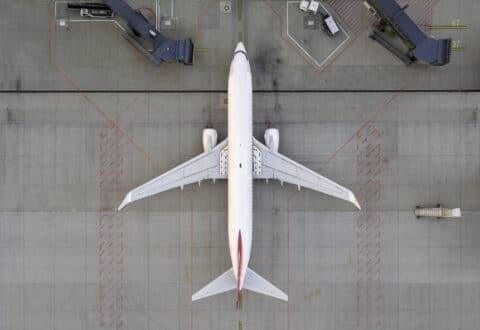Creating a marketing plan for aviation and airline organizations has never been more crucial than it is today because no industry has overcome more recent setbacks or better understands the power of transformation. The COVID-19 pandemic forever changed the aviation industry as we knew it — grounding countless aircraft, cutting billions in revenue, eliminating more than 200 million jobs and changing consumer behavior virtually overnight. However, with those extraordinary setbacks comes emerging opportunity sparking a new era — one dedicated to efficiency and the environment.
According to recent research by Deloitte & Touche, the Global aerospace and defense industry revenue is expected to continue to recover after a difficult few years and with long-term growth prospects for the industry remaining strong. At this pinnacle point in the airline industry, businesses must get the marketing right to find success in the quickly evolving space.
While creating a marketing plan for aviation brands that gets results isn’t easy, when done correctly, it can elevate organizations to the next level and help them achieve their business goals. As an airline and aviation PR and content marketing agency, Communications Strategy Group (CSG®) uses research-informed aviation marketing strategies and a range of digital marketing tactics that are as pioneering as emerging industry technology to break through the increasingly complex and competitive business landscape. Read on to learn how to create the ultimate aviation and aerospace marketing plan that will take your business to the next level.
What Is an Aviation Marketing Plan?
An aerospace marketing plan aligns with an organization’s overall business plan and aims to reach prospective consumers and turn them into engaged customers and brand supporters. A successful aviation marketing plan covers the four P’s of marketing – product, price, place, and promotion — and revolves around a unique value proposition.
The purpose of an aviation marketing plan is to achieve a winning advantage over competitors by understanding the needs of customers and adjusting the tactics to meet those needs. An operational document that outlines the marketing and advertising strategy to generate leads and reach its target market, an aerospace marketing plan details outreach and PR campaigns and measures their effectiveness. Components of a marketing plan include:
- Market research to support pricing decisions and new market entries.
- Messaging that targets specific audience demographics.
- Platforms for product and service promotion, such as digital, radio and trade magazines.
- Metrics that measure results and effectiveness.
Aviation Marketing Plan vs Business Plan
The main difference between a business plan and a marketing plan is that the former should inform the latter. A business plan encompasses the entire business — overall strategy, financial plans, target markets, sales goals, products and services, operations, marketing and advertising tactics, etc. A marketing plan, on the other hand, focuses on the marketing strategy that supports the business plan, including target demographics, messaging, programs and campaigns.
When Is the Best Time to Create a Marketing Plan?
The best time to create an aerospace marketing plan is now. For optimal success, marketing strategies and campaigns need to align with an overall marketing plan created to bolster the overall business plan. If your airline marketing strategies aren’t tied to a singular plan, goal and vision, now is the time to create one. It’s also critical to revisit and revise the plan regularly to ensure it continues to align with your organization’s business goals and the evolving industry landscape.
How to Create a Marketing Plan for Your Aviation and Aerospace Business
Ready to leverage a successful marketing plan for your aviation organization? Consider these five steps:
Understand Your Organization’s Business Plan, Mission, Vision and Values
A firm grasp of the organization’s business plan, purpose and goals is the first step to creating a successful marketing plan. This information will always answer the question of why you’re doing what you’re doing.
Identify the Market and Competition
Once you understand the organization internally, it’s time to explore how it stacks up externally. Studying the competition and industry at large is a vital step in creating a marketing plan. Depending on your marketing budget, this step can range from outside market research to a detailed SWOT (strengths, weaknesses, opportunities and threats) analysis of competitors.
Pinpoint Your Target Audience
Next, it’s time to define your customer. Who are they? What do they want? How do they want to communicate? What’s the best way to engage with them? This step can range from pulling demographic information to creating detailed consumer personas.
Outline Your Marketing Goals
Now it’s time to connect the dots between the business plan and how marketing strategies can help achieve the overall goals and objectives. Marketing goals should include clear statements and real metrics, such as increasing sales by 25% or breaking into three new geographic markets next quarter.
Detail Your Marketing Strategy
Once your goals are set, you can outline how you plan to achieve them. Essentially, this step answers what, how, when and where. For example, the organization will increase sales through a comprehensive digital marketing strategy targeted at a new consumer demographic through the following social media channels during a certain period of time.
Define How the Marketing Plan Will Be Evaluated
Lastly, be sure to include how each step of the marketing plan will be measured. Evaluating results and tweaking the marketing plan accordingly is key to long-term success and lasting results.
How to Execute a Marketing Plan for Aviation
Once a marketing plan has been created, it’s time to execute, measure and evaluate it. A thorough marketing plan will include specifics on who, when, where and how the marketing plan will be executed. From there, the marketing and leadership teams should meet consistently to measure results and evaluate the plan to inform future plans and campaigns.
Remember, a marketing plan can and should be adjusted at any point based on metrics results. Campaigns that are performing better than projected can gain more marketing budget, while tactics that aren’t resonating with target audiences can be reworked.
Tips to Keep in Mind When Creating a Marketing Plan for Your Aviation Company
Taking the time to get the marketing plan right — and consistently evaluating it — is vital to moving the needle and standing out in the increasingly competitive aviation industry. Consider this expert advice when creating an aerospace marketing plan:
Listen to Consumers
Searching for the best way to engage with your target audience? Ask them. Consumers — particularly aviation customers — have no shortage of feedback for the brands they want to fly with. Find creative ways to communicate with both supporters and non-supporters of your brand to inform your marketing plan.
Look for a Gap in the Industry
What’s missing in the airline market? Once you identify what consumers want and can’t currency find, your organization can fill the gap.
Plan for Today, with an Eye on the Future
The aviation industry is all about innovation. Through constant evolution, cutting-edge technology and emerging services, airline organizations continue to achieve new heights. Keep future innovation in mind when creating your airline marketing plan.
Partner with an Aviation Marketing Agency with a Proven Track Record
As the aerospace and aviation industries continue to innovate and expand, so too has the need for the players in those industries to have a sophisticated and knowledgeable communications and marketing agency. The right partner in aviation industry marketing can make or break the conversation around a brand and its achievements. At CSG, we believe that the intersection of industry expertise and genuine passion is where meaningful impact happens.
FAQs About Marketing Plan for Aviation
How do you plan a marketing strategy for your airline company?
Airline marketing strategies involve a supreme understanding of the business’ identity, target markets and message opportunities for the industry at large. From there, the marketing strategy should bolster the overall business plan, be measured often and adjusted accordingly.
How can I promote my aviation business?
There is a spectrum of ways to execute airline advertising tactics that help your airline business gain a competitive edge — from strategic social media campaigns, flight perk programs, bolstering loyalty programs and digital marketing strategies.
What is important for marketing an airline business?
Understanding the airline industry and how your organization’s value proposition fits into it is vital to creating successful airline marketing strategies. It’s also important to understand your airline business’s strengths, weaknesses, opportunities and threats.
What are the best marketing strategies for airlines after COVID-19?
The best aviation marketing strategies in a post-COVID-19 world are ones that understand the transformation in consumer behavior. Consumers want to fly with brands that are focused on environmental impact, that are dedicated to safety measures and that are leading the way in innovation. The brands that can communicate those values through content marketing are the ones that will continue to dominate the industry.
Ready to Develop Your Aviation Marketing Strategy with Us?
As the aviation industry continues to emerge from the impacts of COVID-19, it must respond to the industry’s irreversible shifts and devise business and marketing strategies that adapt to new realities. Contact us today if you’re searching for cutting-edge aviation marketing strategies that will move the needle for your company. As an award-winning aerospace and aviation PR and content management company, CSG is experienced in creating unique aerospace marketing plans that help aviation companies soar to new heights.


